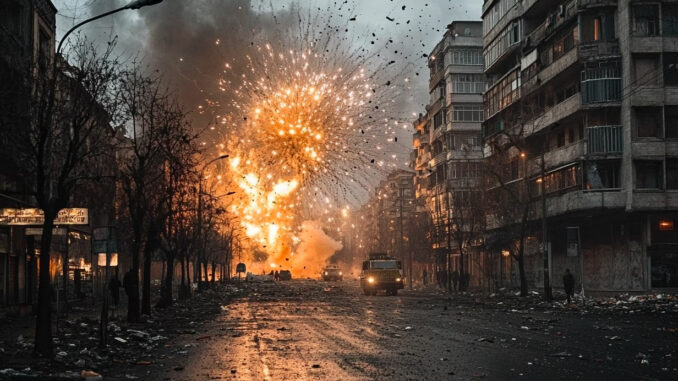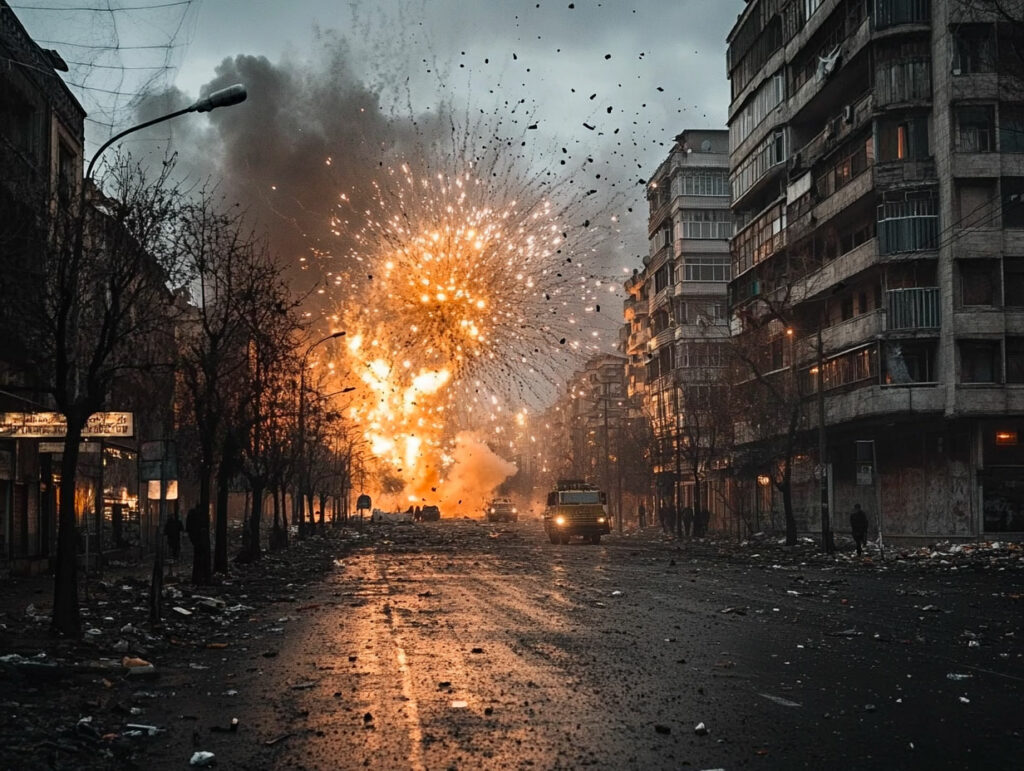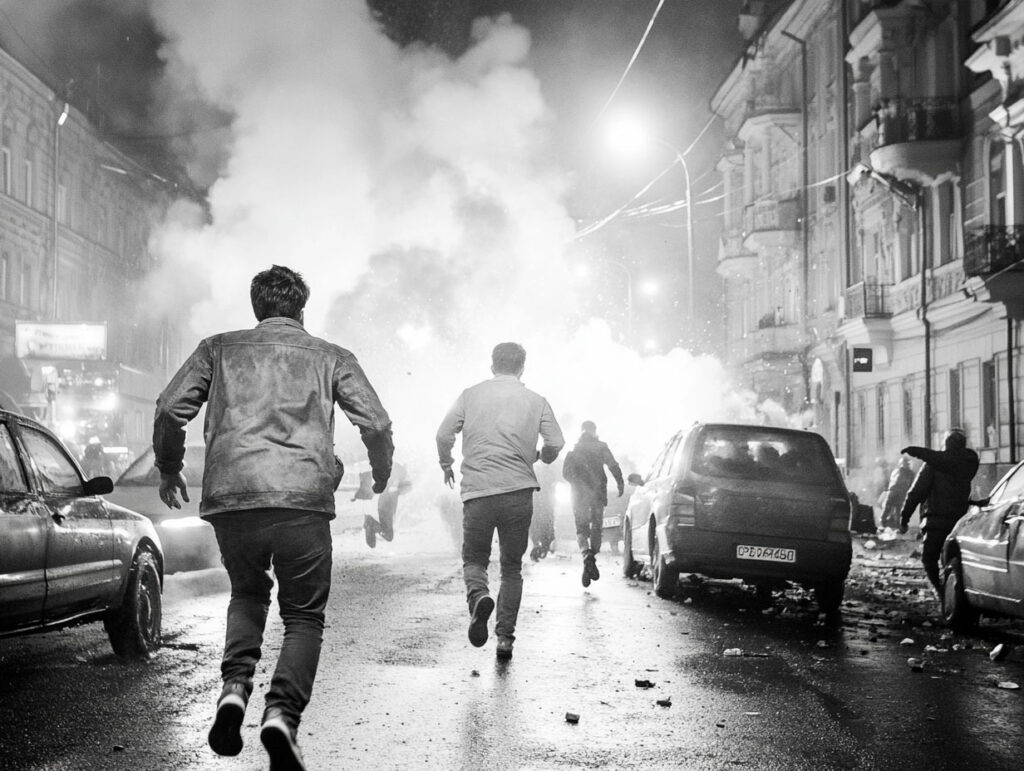
Russia launches 215 missiles and drones on Kyiv and Ukraine in a massive air strike. 186 targets shot down, damage and injuries reported. Technical analysis.
On the night of April 23, 2025, Russia orchestrated a large-scale air strike against Ukraine, mainly targeting Kyiv. With 215 air threats, including 70 missiles and 145 drones, this offensive is one of the largest in recent times. Ukrainian air defenses intercepted 186 targets (48 missiles and 138 drones), mobilizing F-16 and Mirage fighter jets. Fires broke out in nine regions, with 40 blazes extinguished. Infrastructure was damaged, casualties were reported, and a rescue worker was hit during a second wave targeting emergency services. This attack highlights Russia’s strategy of saturating Ukrainian defenses, despite a high interception rate.

Context of the Russian air strike on Ukraine
The attack on April 23, 2025, is part of a series of Russian air offensives aimed at weakening Ukraine militarily and civically. Beginning at 7:30 p.m. local time, the operation mobilized 215 aircraft, including 70 missiles and 145 drones, launched from land, air, and sea platforms. According to the Ukrainian Air Force, the main target was Kyiv, although other regions such as Kharkiv, Dnipropetrovsk, Zhytomyr, Zaporizhzhia, and Khmelnytskyi were also hit. This operation reflects a strategy of saturating air defenses, combining ballistic missiles, cruise missiles, and Shahed drones.
The figures speak for themselves: of 70 missiles, 48 were shot down, and of 145 drones, 138 were neutralized, representing an interception rate of 86.5%. This performance, while remarkable, did not prevent material damage and injuries. For example, in Kyiv, missile debris damaged residential buildings, while critical infrastructure such as power grids was hit in other regions. This attack illustrates Russia’s ability to coordinate complex strikes, but also Ukraine’s resilience in the face of a massive air threat.
Technical composition of the attack
The Russian arsenal deployed included a variety of missiles and drones, each with specific characteristics. The Iskander-M (KN-23 variant), short-range ballistic missiles (500 km), have supersonic speed (Mach 6-7) and an accuracy of 10 meters. Of the 11 launched, 7 were intercepted. The Kh-101, long-range air-to-ground cruise missiles (2,500 km), use inertial and GPS guidance, with a 400 kg explosive payload. Of the 37 launched, 31 were shot down. Six of the 12 Kalibr naval cruise missiles (1,500-2,500 km) were intercepted. The Kh-59/Kh-69 air-to-ground guided missiles (300 km) were all neutralized (4/4). However, none of the six Iskander-K low-altitude cruise missiles were intercepted, revealing a vulnerability to this type of weapon.
The Iranian-made Shahed drones are low-cost aircraft (around €20,000 per unit) with a range of 2,000 km and a payload of 50 kg. Their low speed (180 km/h) makes them detectable, but their number (145) is intended to overwhelm defenses. Ukraine has mobilized F-16 fighter jets (maximum speed 2,400 km/h, equipped with AIM-120 AMRAAM missiles) and Mirage 2000 fighter jets (speed 2,300 km/h, MICA missiles) to counter these threats. Ground-to-air systems such as the Patriot (range 160 km) and the S-300 (range 150 km) completed the defense. This combination resulted in a high interception rate, but the failure to intercept the Iskander-K highlights technological limitations.

Response of Ukrainian air defenses
Ukrainian air defenses demonstrated remarkable effectiveness, intercepting 186 of the 215 targets. The American F-16s, delivered in 2024 (approximately €60 million per unit), played a key role thanks to their AN/APG-83 radar and long-range missiles. The French Mirage 2000s, although less modern, offer agility and the ability to intercept slow-moving targets such as the Shahed. Patriot and S-300 systems targeted ballistic and cruise missiles, while anti-aircraft guns shot down low-flying drones.
However, the failure to intercept the Iskander-K missiles poses a problem. These missiles, with their unpredictable trajectory and Mach 4 speed, are difficult to counter without advanced systems such as THAAD (not deployed in Ukraine). In addition, saturation by Shahed drones forces resources to be spread thin, reducing effectiveness against missiles. For example, in Kharkiv, an Iskander-K missile damaged an electrical substation, depriving 10,000 homes of electricity for six hours. This attack shows that, despite a high interception rate, Ukrainian defenses remain under pressure in the face of combined strikes.
Consequences of the attack on Ukraine
The consequences of the attack are manifold. On the human level, injuries have been reported in six regions, with at least one rescue worker hit during a second wave targeting emergency crews. This tactic, described as deliberate targeting, aims to discourage rescue efforts and amplify panic. In Kyiv, debris damaged 10 residential buildings, affecting 500 residents. In Zaporizhzhia, energy infrastructure was hit, causing power cuts to 20,000 homes.
In terms of material damage, 40 fires were extinguished in nine regions, mobilizing 500 firefighters and 100 vehicles. Damage to energy infrastructure is exacerbating the situation, with Ukraine having already lost 50% of its energy capacity since 2022. These attacks are aimed at weakening civilian morale and complicating military logistics. For example, in Dnipropetrovsk, an industrial plant was damaged, reducing the production of medical equipment by 30%. Strategically, Russia is seeking to deplete Ukraine’s anti-aircraft missile reserves, estimated at 1,000 units for the Patriot system in 2025.
Impact on the population and relief efforts
The attack has had a psychological and logistical impact on the population. Air raid sirens, which went off at 7:30 p.m., forced millions of residents to take shelter in underground bunkers. In Kyiv, around 1.2 million people spent the night in metro stations or bunkers. This disruption is affecting economic productivity, with an estimated loss of €10 million per night of major raids.
Emergency services were directly targeted, a controversial tactic. A rescue worker wounded in Zhytomyr and four damaged vehicles illustrate this strategy. Firefighters, operating under threat, extinguished 40 fires in 12 hours, at an operational cost of around €500,000. This pressure on emergency services reduces their ability to respond to secondary disasters, such as gas leaks or structural collapses. For example, in Khmelnytskyi, a fire destroyed 2,000 m² of a warehouse, affecting food distribution.

Russian strategy and geopolitical implications
Russia’s strategy is based on saturation and exhaustion. By launching 215 drones, Russia is testing the limits of Ukraine’s defenses while targeting critical infrastructure. The inexpensive Shahed drones serve as decoys, forcing Ukraine to use expensive missiles (a Patriot missile costs €4 million). This economic asymmetry aims to drain Ukrainian resources, which are dependent on Western aid.
Geopolitically, this attack comes at a tense time. The US, the main supplier of F-16s and Patriots, delivered $10 billion in military aid in 2024. However, uncertainties about the continuity of this support, particularly after the election of Donald Trump, are weakening Ukraine. France, with its Mirage 2000s, and the EU, through funding, remain key supporters. This attack could prompt allies to speed up deliveries of anti-aircraft systems, but also reignite debates about an escalation of the conflict.
War Wings Daily is an independant magazine.